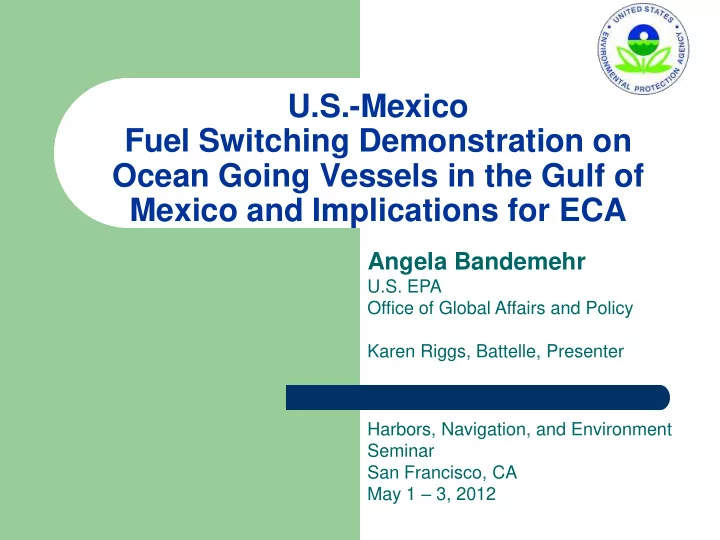

U.S.-Mexico Fuel Switching Demonstration on Ocean Going Vessels in the Gulf of Mexico and Implications for ECA Angela Bandemehr U.S. EPA Office of Global Affairs and Policy Karen Riggs, Battelle, Presenter Harbors, Navigation, and Environment Seminar San Francisco, CA May 1 – 3, 2012
Background Contribution of shipping to PM2.5 concentrations (in μ g/m3) Worldwide Ship PM-Related Mortality
Project Partners Port of Houston Authority U.S. Maritime Administration Mexican Ministry of Environment/PEMEX Maersk Line/Hamburg Süd ICF, University of California at Riverside, and Battelle
Project Goals Demonstrate Switching to Low Sulfur Distillate Fuels in Gulf of Mexico Measure Emission Reductions Estimate Emission Reductions at Mexican Ports from Fuel Switching Estimate Health and Environmental Benefits from Fuel Switching Raise Awareness of upcoming Emission Control Area
North American Emission Control Area
Caribbean ECA
2020 Potential ECA PM 2.5 Reductions
2020 Potential Sulfur Deposition Reductions Improvements in deposition for marine and terrestrial ecosystems %
Project Design Demonstration of fuel switching on two ocean going vessels of Maersk and Hamburg Süd – Fuel switched from high sulfur heavy fuel oil (>3.0% sulfur) to marine gas oil (< 0.1% sulfur) Stack emission monitoring Modeling – Port emission inventories, air quality, loadings
Maersk Demonstration Maersk Roubaix – Container Ship – 1118 TEUs – 9.7 MW Propulsion Engine – Medium Speed Engine Switched from Bunker Fuel (3.3% Sulfur) to Distillate Fuel (0.14% Sulfur) 24 nm from shore at Port of Houston and Port of Progreso, Mexico Calculated Emission Reductions per call at Progreso – 27 kg NOx (7%) – 47 kg PM 2.5 (81%) – 479 kg SOx (88%) – 2% increase in operating costs
Hamburg Süd Demonstration Cap San Lorenzo – Container Ship – 3,739 TEUs – 28.8 MW Propulsion Engine – Slow Speed Engine Represents 40% of container ships and 20% of all ships calling on Veracruz and Altamira Stack emissions measured in port and at sea at Altamira, Veracruz and Houston
Observed Operational Findings No significant issues encountered No additional training needed for crew involved in this demonstration Cost and Availability of Low Sulfur Fuel – Additional cost for fuel switch represents less than 2% of voyage costs – Demonstration fuel available in U.S. Tank Size – Sufficient capacity to carry MGO for demonstration Fuel Switching Procedure – Boilers must be slowly turned down – Switch over took about an hour
Emission Sampling Measurements of in-use stack emissions and their reduction from fuel switching MARPOL NOx Technical Code (NTC) and other protocols – Specific engine loads and transient operations, main and auxiliary – engines Pollutants measured • NOx, CO, CO 2 continuously • PM continuously and speciated PM (EC, OC) with discrete filter samples • Measure SO 2 and calculate SOx from fuel measurements
Propulsion Engine Results – SO2 25 HFO (3.79% S) 20 MGO (0.01% S) Emission Factor (g/kWh) 15 10 5 0 Dead Slow Half Full Top Speed
Propulsion Engine Results – PM 2.5 4.0 HFO (3.79% S) 3.5 MGO (0.01% S) 3.0 Emission Factor (g/kWh) 2.5 2.0 1.5 1.0 0.5 0.0 Dead Slow Half Full Top Speed
Fuel Switching Emissions HFO -> MGO Time (seconds)
Reductions from Fuel Switching in Port of Veracruz With 24 nm Boundary 1,600 1,400 5% Emissions (Metric Tonnes) 1,200 HFO (3.0% S) MGO (0.1% S) 1,000 800 600 400 200 87% 78% 0 NOx PM2.5 SOx Emission Inventory based on 2005 activity data
Veracruz Emissions by Ship Type Tanker RoRo RoRo SOx PM 2.5 Tanker 6% 3% 3% 6% Reefer Reefer 0% 0% Auto Auto Carrier Carrier General 19% General 19% 16% Bulk 16% Bulk Carrier Carrier 17% 18% Container Container 39% 38%
Effect of Fuel Switching Zone Size for Port of Veracruz 4,500 4,000 4.3x 3,500 24 nm 200 nm Emission Reductions 3,000 (Metric Tonnes) 2,500 2,000 1,500 1,000 4.4x 500 4.8x 0 NOx PM2.5 SOx
Dispersion Modeling Estimated Annual Total Deposition of SO 2 to Reefs in Veracruz Percent Reef Units HFO MGO Difference Reduction m 2 Area 283,474,477 g/m 2 Reef Area 1 Total Annual SO 2 Flux 0.19 0.01 0.18 Total Annual Deposition kg 53,000 1,900 52,000 96% m 2 Area 57,673,276 g/m 2 Reef Area 2 Total Annual SO 2 Flux 0.0093 0.00081 0.008 Total Annual Deposition kg 540 47 490 91% Total Annual SO 2 Total kg 54,000 2,000 52,000 96% Deposition
Raising Awareness Meetings and Workshops – Mexico City – Veracruz – U.S. Gulf States Aquarium Kiosk - Video Press Releases Web site Final Report www.epa.gov/international/fuelswitch.html
Summary Fuel switching can significant reduce PM and SOx emissions Fuel switching within 24 nm reduces annual emissions of PM by 78% and SOx by 87% at the Port of Veracruz Deposition of SOx on sensitive reefs around Veracruz reduced by 52 Metric Tonnes per year (96%) Final Report available at http://www.epa.gov/international/fuelswitch.html
Outcomes Awareness of North American ECA and implications for Mexico Initiating technical studies needed to determine impacts of an ECA on Mexican public health and environment, if Mexico were to adopt an ECA
Recommend
More recommend